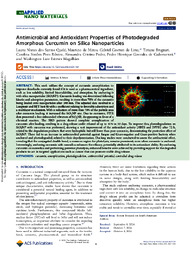Embrapa Florestas
 Busca de publicações
Busca de publicações
Antimicrobial and antioxidant properties of photodegraded amorphous curcumin on silica nanoparticles.
Autoria: QUELÉ, L. N. dos S.; MATOS, M. de; LIMA, G. G. de; BRUGNARI, T.; RIBEIRO, C. S. P.; PEDRO, A. C.; CADEMARTORI, P. H. G. de; MAGALHAES, W. L. E.
Resumo: This work utilizes the concept of curcumin amorphization to improve drawbacks currently found if it is used as a pharmaceutical ingredient, such as low solubility, limited bioavailability, and absorption, by anchoring it with silica nanoparticles (SiO2NP). Curcumin loading was determined following kinetic and adsorption parameters, resulting in more than 70% of the curcumin being loaded onto nanoparticles after 180 min. The adjusted data resulted in a Langmuir and BET best-fit with a coefficient relating to favorable adsorption and a multilayer mechanism. With a reduction of more than 70% of the particle area after curcumin loading, it increased the SiO2NP size. Due to curcumin, FTIR data presented a free unbounded vibration of SiO2NP, disappearing in favor of a chemical reaction. The XRD pattern showed complete amorphization of curcumin after loading, resulting in a drug release under ethanol of up to 41% in 30 days. To improve this, photodegradation on SiO2NP with curcumin was performed, showing a vast improvement of the antioxidant activity (ABTS and DPPH) after 72 h, related to the degradation products that were hydrophilic but still lower than pure curcumin, demonstrating the protection effect of SiO2NP. These led to an increase in antimicrobial potential against fungus and Gram-negative and Gram-positive bacteria when anchored and photodegraded, related to their depolymerization. Docking studies were conducted to assess the antibacterial effect, revealing that the conjugated double bond, a common region for photolysis, remains prominent, even when curcumin is anchored. Interestingly, anchoring curcumin with nanosilica enhances the efficacy, potentially attributed to its antioxidant ability. By anchoring curcumin on nanosilica and performing posterior photolysis, enhanced benefits were achieved by providing support for the degraded products to act in targeted applications such as cancer that can promote stable drug release. KEYWORDS: curcumin, amorphization, photodegradation, antimicrobial potential, controlled drug re
Ano de publicação: 2024
Tipo de publicação: Artigo de periódico
Unidade: Embrapa Florestas

